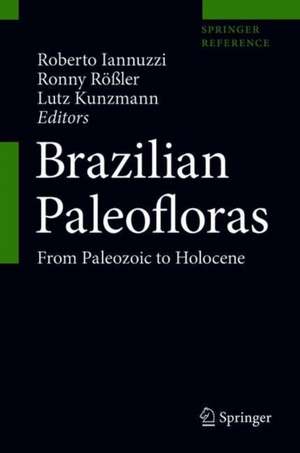Brazilian Paleofloras: From Paleozoic to Holocene
Editat de Roberto Iannuzzi, Ronny Rößler, Lutz Kunzmannen Limba Engleză Hardback – 19 mar 2025
Preț: 2756.82 lei
Preț vechi: 3909.24 lei
-29% Nou
Puncte Express: 4135
Preț estimativ în valută:
527.56€ • 551.48$ • 445.81£
527.56€ • 551.48$ • 445.81£
Carte nepublicată încă
Doresc să fiu notificat când acest titlu va fi disponibil:
Se trimite...
Preluare comenzi: 021 569.72.76
Specificații
ISBN-13: 9783030225254
ISBN-10: 3030225259
Pagini: 1250
Ilustrații: Approx. 1000 p. 300 illus., 100 illus. in color.
Dimensiuni: 155 x 235 mm
Ediția:1st ed. 2024
Editura: Springer International Publishing
Colecția Springer
Locul publicării:Cham, Switzerland
ISBN-10: 3030225259
Pagini: 1250
Ilustrații: Approx. 1000 p. 300 illus., 100 illus. in color.
Dimensiuni: 155 x 235 mm
Ediția:1st ed. 2024
Editura: Springer International Publishing
Colecția Springer
Locul publicării:Cham, Switzerland
Cuprins
Introduction: Historical overview of Palaeobotany in Brazil.- ECTION 1: PALEOZOIC.-1. First evidences of terrestrial plants in Brazil.-2. Plant diversification through the Middle Devonian in Brazil.- 3. Mississippian plants from the Parnaíba Basin.- 4. Origin and diversification of plants in Brazil during the Silurian-Mississippian interval: microfloral record.- 5. Pennsylvanian Ice Age Flora from the Paraná Basin.- 6. Diversity and growth forms of tree ferns in the Permian in Brazil.- 7. Growth architecture of calamitaleans of the Permian in Brazil.- 8. Arborescent gymnosperms of the Permian from the Parnaíba Basin.- 9. Petrified wood in the Permian of NE Brazil. Sedimentary environment and petrification pathways.- 10. Interactions among plants and other organisms in the Permian of the North East region of Brazil.- 11. Presence of callipterids in Parnaíba Basin and phytogeographic implications.- 12. Geoconservationof Permian Petrified Forests from the North East region of Brazil.- 13. Bryophytes from the Permian in Brazil.- 14. Permian lycophytes from the Paraná Basin.- 15. Diversity and stratigraphic distribution of sphenophytes in the Permian of the Paraná Basin.- 16. Ferns from the Permian of the Paraná Basin and their paleoecological interpretations.- 17. Record of glossopterid plants in the southern region of Brazil.- 18. Relictual elements and other rare taxa from the Glossopteris Flora in Brazil.- 19. Conifers and aliens forms in the Permian in Brazil.- 20. Wildfires in Permian strata in Brazil.- 21. Evidences of arthropod- plant interactions through the Permian in Brazil.- 22. Ice-hothouse transition and palynological evidences in Brazil.- SECTION 2: MESOZOIC.- 23. Petrified woods in the Triassic of the Southern region of Brazil.- 24. Corystospermales and aliens elements from the Paraná Basin.- 25. Conifers and othergymnosperms from the Paraná Basin in the Southern region.- 26. The Crato flora, a 110 Million years old window into the Cretaceous world of Brazil.- 27. The Crato lake deposits. Sediments to preserve an extraordinary fossil lagerstaette.- 28. Gnetophyte diversity in northern Gondwana.- 29. Conifers of the Early Cretaceous Crato flora with particular focus on whole-plant aspects.- 30. Angiosperms in the Early Cretaceous of northern Gondwana – a track record.- 31. Paleowildfires in the Araripe Basin: paleoenvironmental and paleoclimate implications.- 32. Ecosystem structure and trophic network in the late Early Cretaceous Crato biome.- 33. Insect-plant interactions in the Crato vegetation.- 34. Other Cretaceous floras of Brazil.- 35. Cretaceous microfloras of Brazil: paleoenvironmental and palaeoclimatic significance.- SECTION 3: CENOZOIC.- 36. Ancient tropical floras in South American lowland terrains at the beginning of Cenozoic.- 37. Going towards the modern Brazilian vegetation: Neogene floral records.- 38. Cenozoic palynological record in Brazil and paleoclimate significance.- 39. Reconstructing the Quaternary tropical floras from the palynological record in Brazil.- 40. Subtropical palynofloras: interpreting the climate changes during the Holocene in Brazil.- 41. Brazilian Quaternary floral record.
Notă biografică
Roberto Iannuzzi is a Brazilian biologist and holds a PhD in Geosciences from the Federal University of Rio Grande do Sul (UFRGS). He is currently a Full Professor at UFGRS, where he also coordinates the Institute of Geosciences Research Committee. He was the president of the Brazilian Society of Paleontology from 2009 to 2013 and has published over 80 articles in peer-reviewed journals. He has also published some books in Portuguese, such as Paleobotânica (2005) and Antes dos Dinossauros (2004) (Before the dinosaurs).
Ronny Rößler is a German geologist, holds a PhD from Technical University Bergakademie Freiberg where he became an honorary professor in 2017. Director of the Museum of Natural History at Chemnitz since 1995, he is also one of the editors-in-chief of the journal Palaeontographica B and served in the advisory board of the Paleontological Society from 2008 to 2010.
Lutz Kunzmann is a German paleontologist and holds a PhD from the Humboldt University. Head of section and curator of paleobotany at Senckenbert Natural History Collections since 1994, he is currently the treasurer of the International Organisation of Palaeobotany and one of the editors-in-chief of Palaeontographica B.
Caracteristici
Presents the evolution of terrestrial plants recorded in Brazilian sedimentary rocks over the last 400 million years Ranges from the first evidence of terrestrial plants in the South American lowlands until its Quaternary floras Discusses paleoenviromental and paleoclimatic significance of these evidences and includes palinological records
